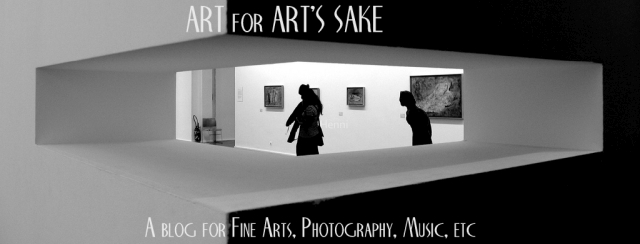Many years ago, ar(t)chitecture was one of the subjects of this blog. For today's post, I'll share some of the (for my taste) most beautiful architectural designs of the past one hundred years, without featuring the same architects twice (sorry, Señor Calatrava...). The image above is made with Photofunia.
Fallingwater (1939)
Fallingwater is a house designed by the architect Frank Lloyd Wright in 1935 in the Laurel Highlands of southwest Pennsylvania. It is built partly over a waterfall on Bear Run in the Mill Run section of Stewart Township, Fayette County, Pennsylvania. After its completion in 1939, Time called Fallingwater Wright's "most beautiful job" and it is listed among Smithsonian's "Life List of 28 Places to See Before You Die" (Wikipedia).
Image by lachrimae72 - CC0
Notre-Dame du Haut (1955)
Notre-Dame du Haut (English: Our Lady of the Heights; full name in French: Chapelle Notre-Dame du Haut) is a Roman Catholic chapel in Ronchamp, France. Built in 1955, it is one of the finest examples of the architecture of Franco-Swiss architect Le Corbusier. The chapel is a working religious building and attracts 80,000 visitors each year (Wikipedia).
Image by Valueyou (talk), CC BY-SA 3.0.
Sydney Opera House (1973)
The Sydney Opera House is a multi-venue performing arts centre in Sydney. Located on the banks of Sydney Harbour, it is widely regarded as one of the world's most famous and distinctive buildings and a masterpiece of 20th century architecture. Designed by Danish architect Jørn Utzon, but completed by an Australian architectural team headed by Peter Hall, the building was formally opened on 20 October 1973 (Wikipedia).
Image by Bernard Spragg. NZ from Christchurch, New Zealand - Sydney Australia., CC0.
Hallgrímskirkja (1986)
Hallgrímskirkja (Church of Hallgrímur) is a Lutheran (Church of Iceland) parish church in Reykjavík, Iceland. State Architect Guðjón Samúelsson's design of the church was commissioned in 1937. He is said to have designed it to resemble the trap rocks, mountains and glaciers of Iceland's landscape. It took 41 years to build the church: construction started in 1945 and ended in 1986, but the landmark tower was completed long before the whole church was finished (Wikipedia).
Image by Someone35 - Own work, CC BY-SA 3.0.
The Niterói Contemporary Art Museum is situated in the city of Niterói, Rio de Janeiro, Brazil, and is one of the city’s main landmarks. It was designed by Oscar Niemeyer with the assistance of structural engineer Bruno Contarini
No machine-readable source provided. Own work assumed (based on copyright claims)., CC BY-SA 2.5.
Guggenheim Museum Bilbao (1997)
The Guggenheim Museum Bilbao is a museum of modern and contemporary art designed by Canadian-American architect Frank Gehry, and located in Bilbao, Basque Country, Spain. The museum was inaugurated in 1997 by King Juan Carlos I of Spain. One of the most admired works of contemporary architecture, the building has been hailed as a "signal moment in the architectural culture", because it represents "one of those rare moments when critics, academics, and the general public were all completely united about something", according to architectural critic Paul Goldberger (Wikipedia).
Image by PA - Own work, CC BY-SA 4.0.
Burj Al Arab (1999)
The Burj Al Arab (Arabic: Tower of the Arabs) is a luxury hotel located in the city of Dubai, United Arab Emirates. The building was designed by the multidisciplinary consultancy Atkins, led by architect Tom Wright. The design and construction were managed by Canadian engineer Rick Gregory, also of WS Atkins. Construction of the island began in 1994; the building opened on 1 December 1999 (Wikipedia).
Auditorio de Tenerife (2003)
The Auditorio de Tenerife "Adán Martín" (commonly referred to as the Auditorio de Tenerife) is an auditorium in Santa Cruz de Tenerife, Canary Islands, Spain. Designed by architect Santiago Calatrava, it is located next to the Atlantic Ocean in the southern part of Port of Santa Cruz de Tenerife. Construction began in 1997 and was completed in 2003. The building is framed within the tenets of late-modern architecture of the late 20th century (Wikipedia).
Image by Diego Delso, CC BY-SA 3.0.
John Curtin School of Medical Research (2006)
The John Curtin School of Medical Research (JCSMR) is an Australian multidisciplinary translational medical research institute and postgraduate education centre that forms part of the Australian National University (ANU) in Canberra. The school was founded in 1948. The depicted buildings were constructed in stages over seven years by Hindmarsh Construction Australia. The design of the building is influenced by the DNA double helix and provides education, conference, and secure research laboratory facilities (Wikipedia).
Image by Angelo Tsirekas - Own work, CC BY-SA 3.0.
Capital Gate (2011)
Capital Gate, also known as the Leaning Tower of Abu Dhabi, is a skyscraper in Abu Dhabi that is over 160 meters tall, 35 stories high, and was designed to incline 18° west (a world record). It was designed by RMJM from Edinburgh, Scotland (Wikipedia).
Image by FritzDaCat - Own work, CC BY-SA 3.0.
Heydar Aliyev Center (2012)
The Heydar Aliyev Center is a building complex in Baku, Azerbaijan designed by Iraqi-British architect Zaha Hadid and noted for its distinctive architecture and flowing, curved style that eschews sharp angles (Wikipedia).
Image in public domain (link).
The EYE Filmmuseum is located in the Overhoeks neighborhood of Amsterdam in the Netherlands. It was designed by Delugan Meissl Associated Architects. The museum hosts the cinematic collection of EYE Film Institute Netherlands.
Image by Jvhertum - Own work, CC BY-SA 3.0.
Copyright statement: see remarks at each individual image.




.jpg)








